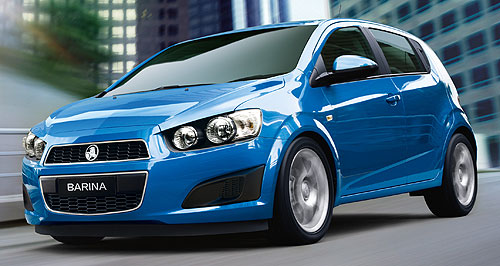First drive: Holden’s baby Barina grows up
BY BYRON MATHIOUDAKIS | 20th Sep 2011

Available from November, the second Korean-built Barina, known as the T300 or TM series, will initially arrive in a single but well-equipped five-door bodystyle.
A special introductory price of $16,990 driveaway will apply for the five-speed manual TM Barina, for its first few months on sale at least.
It will complement the significantly smaller (and unrelated) sub-light MJ Barina Spark four-seater hatch range launched in October 2010, in $12,490 CD and $14,490 CDX guises.
A six-speed automatic transmission – cheekily dubbed ‘Hydra-Matic’ despite it having nothing to do with the three-speed item found in the 1961 EK as Holden’s first such gearbox – comes complete with a thumb-controlled sequential shift facility, and is available for an extra $2000.
Meanwhile, until the four-door TM sedan usurps it from early 2012, the existing Daewoo-based TK Barina sedan will continue, along with runout stocks of the TK hatch. Both will be rebranded ‘Barina Classic’ to help differentiate old from new.
Stylistically, Holden believes the latest Barina will have a more ‘gender neutral’ appeal than either its TK predecessor or MJ Spark sibling. The work of Holden designer Ondrej Koromhaz, the T300 was inspired by the concept of a four-wheel motorcycle, with most of the work carried out in Korea.
Notable elements – some shared with the Spark, which emerged from the same design studio – include a wide stance, flared wheel-arches, ‘raw’ headlight and tail-light detailing, a pronounced upswept wedge,and concealed rear door-handles.
At 4039mm long, 1735mm wide and 1517mm high, the TM is one of the larger cars in its segment, sitting on a 2525mm wheelbase with front and rear track widths of 1497mm and 1495mm respectively.
Underneath the Barina is a conventional transverse-engine, front-wheel drive architecture based on General Motors’ Gamma platform that also underpins a variety of models sold overseas, including the Opel Corsa and Fiat (Grand) Punto.
Co-developed by GM Korea, with significant input from Opel in Germany and Holden in Australia, the T300 features MacPherson struts up front and a torsion beam rear axle with a 21mm hollow-type anti-roll bar.
To combat the outgoing TK model’s poor noise, vibration and harshness properties, Holden says it focussed on specific acoustical applications (basically sound-deadening material) in areas such as the floor, headlining, instrument panel, inner body panels and doors, while a long six-mount engine cradle and thicker window glass help put it “among the best in its competitive segment”.
There are also new acoustic resonators on the engine intake system to further cut noise paths.
For now, only one engine is available – a revised ‘Generation III’ version of GM’s long-lived 1598cc 1.6-litre Family One four-cylinder petrol unit.
Featuring dual overhead camshafts with continuously variable phasing and a variable intake manifold, the Barina boasts an 11 and seven per cent increase in power (85kW at 6000rpm) and torque (155Nm at 4000rpm) respectively, while fuel consumption falls by 0.1 litres per 100km for the manual (6.8L/100km) and 0.5L/100km for the 6T30 Hydra-Matic auto (7.3L/100km).
The carbon dioxide emission rating is 162 grams per kilometre (auto: 174g/km).
Steering is via a hydraulic power-assisted rack-and-pinion set-up, while the front brakes are ventilated discs at 256mm in diameter, with 230mm drums out back.
Aiding the stoppers on every TM Barina is electronic stability control (a first for the series), anti-lock brakes, traction control, brake assist and electronic brake-force distribution.
Along with dual front airbags, front-side and curtain airbags, front seatbelt pretensioners, seatbelt reminders, collapsible pedals and five head restraints, the Barina scores a five-star ANCAP crash test safety rating.
Bluetooth telephony with audio streaming, USB input and iPod connectivity, steering wheel-mounted controls, 'follow me home' headlights, air-conditioning, remote central locking and power windows are also included.
No other light-car features all these features plus cruise control and alloy wheels for under $16,000, the company states.
The motorcycle influence extends to the dashboard, which features a combination of analogue tachometer and digital speedo readouts, while special attention was paid to provide a plethora of storage spaces for items such as iPhones and MP3 players.
The aforementioned alloys are 15-inch in diameter, shod with 195/65 R15 tyres, while a tyre inflator kit is standard – though as a no-cost option Holden will fit a 15x6.0-inch full-size steel wheel. Without that, the boot space varies from a seats-up 290 litres to 653 litres with the rear backrest laid down fully flat.
Two flat colours are available – white and red – while more money will buy Barina customers a choice of grey, silver, silvery blue, bright blue and black metallic paints. The latter also dominates the cloth seats inside.
Holden will continue to source its newest light car from its sister GM subsidiary in South Korea, although there is very little in common between the newcomer and its T200 predecessor, which began life as the Daewoo Kalos in 2002.
Now in its sixth generation, the Barina has been imported from a variety of places, kicking off with a model twinned with the first two Suzuki Swift generations from Japan between early 1985 and mid-1994, followed by the third-generation SB and its 2001 XC successor from Spain, via GM Opel.
| Holden Barina pricing: | |
| Hatch | $15,990 |
| Hatch (a) | $17,990 |